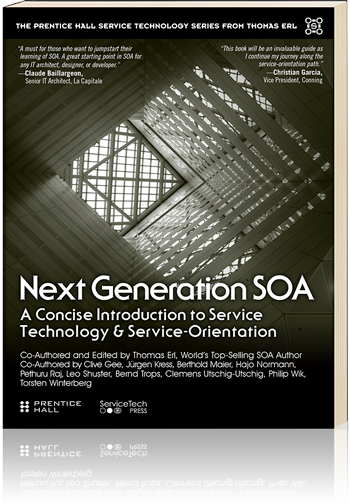Acknowledgments
Chapter 1: Introduction
About This Book
Who This Book Is For
What This Book Does Not Cover
How This Book Is Organized
Additional Information
Updates, Errata, and Resources (www.servicetechbooks.com)
Service Technology Specifications (www.servicetechspecs.com)
The Service Technology Magazine (www.servicetechmag.com)
Service-Orientation (www.serviceorientation.com)
What Is REST? (www.whatisrest.com)
What Is Cloud? (www.whatiscloud.com)
SOA and Cloud Computing Design Patterns
(www.soapatterns.org, www.cloudpatterns.org)
SOA Certified Professional (SOACP) (www.soaschool.com)
Cloud Certified Professional (CCP) (www.cloudschool.com)
Big Data Science Certified Professional (BDSCP)
(www.bigdatascienceschool.com)
Notification Service
Chapter 2: An Overview of SOA & Service-Orientation
Services and Service-Orientation
Service-Orientation, Yesterday and Today
Applying Service-Orientation
The Eight Principles of Service-Orientation
The Four Characteristics of SOA
The Four Common Types of SOA
SOA Design Patterns
The Seven Goals of Applying Service-Orientation
Planning For and Governing SOA
The Four Pillars of Service-Orientation
The Seven Levels of Organizational Maturity
SOA Governance Controls
Chapter 3: A Look at How Services are Defined and Composed
Basic Concepts
Agnostic and Non-Agnostic Logic
Service Models and Service Layers
Service and Service Capability Candidates
Breaking Down the Business Problem
Functional Decomposition
Service Encapsulation
Agnostic Context
Agnostic Capability
Utility Abstraction
Entity Abstraction
Non-Agnostic Context
Process Abstraction and Task Services
Building Up the Service-Oriented Solution
Service-Orientation and Service Composition
Capability Composition and Capability Recomposition
Capability Composition
Capability Recomposition
Domain Service Inventories
Chapter 4: An Exploration of Service-Orientation with the SOA Manifesto
The SOA Manifesto
The SOA Manifesto Explored
Preamble
Priorities
Guiding Principles
Chapter 5: An Overview of Service Technology
Web-Based Services
SOAP-Based Web Services
REST Services
Components
Service Virtualization
Cloud Computing
API Management
Model-Driven Software Design
Semantic Web
Business Process Management
Composition and Orchestration
Master Data Management
Business Rule Engines
Social Network Technologies
Mobile Computing
Agent-Driven Architecture
Event-Driven Architecture and Complex Event Processing
Business Intelligence
Enterprise Information Integration and Extract-Transform-Load
Big Data
Chapter 6: A Look at Service-Driven
Industry Models
The Enterprise Service Model
The Virtual Enterprise Model
The Capacity Trader Model
The Enhanced Wholesaler Model
The Price Comparator Model
The Content Provider Model
The Job Market Model
The Global Trader Model
Industry Watchdogs
Guarantors
Chapter 7: A Case Study
Systems Landscape
New Marketing Strategy
Corporate Culture
Vehicle Maintenance
The Billing System
Strategic Considerations
Cloud Adoption
New Reference Architecture
The Customer Profile Process
New Service Technology
The SOA Governance Program Office
The Enterprise Architecture Board
A Transformed Enterprise
APPENDICES
Appendix A: Additional Reading for Applying Service-Orientation
The Eight Service-Orientation Principles
Standardized Service Contract
Service Loose Coupling
Service Abstraction
Service Reusability
Service Autonomy
Service Statelessness
Service Discoverability
Service Composability
The Four Characteristics of SOA
Business-Driven
Vendor-Neutral
Enterprise-Centric
Composition-Centric
SOA Design Patterns
Appendix B: Additional Reading for Planning & Governing Service-Orientation
The Four Pillars of Service-Orientation
Teamwork
Education
Discipline
Balanced Scope
The Seven Levels of Organizational Maturity
Service Neutral Level
Service Aware Level
Service Capable Level
Business Aligned Level
Business Driven Level
Service Ineffectual Level
Service Aggressive Level
SOA Governance Controls
Precepts
Processes
People (Roles)
Metrics
Appendix C: Additional Reading for Cloud Computing
Goals and Benefits
Reduced Investments and Proportional Costs
Increased Scalability
Increased Availability and Reliability
Risks and Challenges
Increased Security Vulnerabilities
Reduced Operational Governance Control
Limited Portability Between Cloud Providers
Multi-Regional Compliance and Legal Issues
About the Authors
Thomas Erl
Clive Gee, PhD
Jürgen Kress
Berthold Maier
Hajo Normann
Pethuru Raj
Leo Shuster
Bernd Trops
Clemens Utschig-Utschig
Philip Wik
Torsten Winterberg


